In this article, we will analyze the decentralization of Solana through data analysis, highlighting the areas where the network has shown relatively strong decentralization while pointing out areas that need further progress.
Written by: Lostin, Helius
Translated by: Yangz, Techub News
Abstract
- As of Epoch 685, Solana has 4,514 nodes, including 1,414 validators and 3,100 RPCs. No validator controls more than 3.2% of the staked share.
- The Nakamoto Coefficient (NC) represents the minimum number of independent entities that can collude maliciously to cause a failure of validity, thereby refusing to reach the consensus required for new block production. Solana's Nakamoto Coefficient is currently 19, but the actual number may be lower, as a single entity can operate multiple validators anonymously.
- Solana's validators are distributed across 37 countries and regions. The largest concentration of validators is in the United States, with a total of 508. Additionally, four jurisdictions each hold more than 10% of the share, with the U.S. at 18.3%, the Netherlands and the UK at 13.7% each, and Germany at 13.2%.
- 68% of the staked amount is delegated to validators in Europe, with 50.5% delegated to validators within the EU (excluding Norway, Ukraine, and the UK). Furthermore, 20% is delegated to North America.
- Validators are distributed among 135 different hosting service providers. Among them, Teraswitch and Latitude.sh (formerly Maxihost) are two leading providers, with the former being a private U.S. company providing hosting services to validators, accounting for a total of 24% of the share; the latter is a Brazilian company providing low-cost bare-metal servers to validators, accounting for a total of 19% of the share.
- The Agave client codebase has 357 individual contributors. The Firedancer client is developed by a small team led by Chief Scientist Kevin Bowers, currently with 57 contributors.
- The Jito client is a fork of the Agave original codebase, containing an auction for off-protocol block space, currently holding an 88% dominant share in the network. However, as the new Firedancer client is gradually introduced and integrated into the ecosystem, significant changes are expected in the next 12 months. Solana and Ethereum are currently the only L1s offering multiple client implementations.
- Significant changes to Solana's core components require a formal, public Solana Improvement and Development (SIMD) proposal process. The most significant protocol changes, especially those affecting economic parameters, must go through governance voting. So far, three such votes have been conducted.
- The Solana Foundation, established in June 2019, is a non-profit organization registered in Switzerland, dedicated to the development and support of the Solana ecosystem. The foundation's team is relatively lean, consisting of 60-65 full-time employees responsible for overseeing funding sources for grants, delegation programs, and developer tools.
- Additionally, the geographical diversity of the Solana developer community is strongly evidenced. The recent hackathon event "Radar" attracted 13,672 participants from 156 countries, with high participation from India, Nigeria, the United States, and Vietnam. SuperTeam is a network connecting Solana creators, developers, and operators, which has now expanded to 1,300 members across 16 countries.
Why Decentralization
Decentralization can be summarized as the absence of a single point of failure within a system. This multi-faceted concept involves various aspects, including token distribution, the influence of key individuals, participation in permissionless networks, development control, and software/hardware diversity. Aside from Balaji's Nakamoto Coefficient, there are almost no recognized standards for quantifying the degree of decentralization in blockchains. Many metrics are imperfect. Furthermore, discussions around blockchain decentralization are often rooted in political philosophy, leading to profound ideological debates, sometimes bordering on religious disputes.
Solana's degree of decentralization has been criticized by certain blockchain communities, who argue that Solana lacks decentralization and resistance to censorship. A recent example is former NSA whistleblower Edward Snowden, who expressed his concerns during a keynote speech at the Token2049 conference.
However, like many of Solana's critics, Snowden did not provide any data to substantiate his claims, despite being publicly invited to do so. In the following sections of this article, we will analyze Solana's decentralization through data, emphasizing the areas where the network has demonstrated relatively strong decentralization while pointing out areas that need further progress.
Aspects of Decentralization
Through this report, we will adopt a quantitative and multi-faceted approach to analyze Solana's decentralization based on facts and publicly verifiable information.
We will evaluate the following aspects:
- Staking distribution
- Geographical distribution of nodes
- Diversity of hosting service providers
- Diversity of client software
- Diversity of developers
- Governance processes and entities
Where appropriate, we will compare Solana's metrics with other PoS L1s. It should be noted that peer networks are only used as benchmarks to provide a broader context for Solana's decentralization journey and to highlight areas where it may lag or exceed expectations. These comparisons should not be misconstrued as attempts to claim one network is superior to another.
In many cases, Ethereum provides the most useful benchmark, as it is widely regarded as the most decentralized PoS L1. Notably, Ethereum's genesis block was produced in July 2015, while Solana's genesis block was produced in March 2020. Decentralization is dynamic, and blockchains often become more decentralized over time. Under similar conditions, it is reasonable to expect that older chains will have a higher degree of decentralization.
Staking Distribution
The staking distribution of a blockchain network refers to how its native tokens are distributed among validators. In a well-distributed system, no single validator or small group holds an excessive share of the staked amount, thereby reducing the risk of any entity unduly influencing or controlling network consensus.
A balanced staking distribution ensures validator diversity, promoting decentralization and making it difficult for any malicious actor to compromise the integrity of the network. As the network's resilience to the failure of a single validator increases, it also helps enhance fault tolerance.
"You need a very large set of validators; intuitively, the larger the set of validators, the more secure the network, and academically, the larger the set of nodes, the easier it is to guarantee that a minimum spanning tree (spanning tree) can always be accessed by the few honest nodes in that set. This is not even about the protocol layer; it's about people talking on the phone. In fact, people can enter Discord or IRC, or call each other on their phones. And that's the key to solving the split problem and figuring out where the problem is. The more people we have, the easier it is to guarantee that splits are impossible." — Anatoly Yakovenko, Breakpoint 2024
Running a node on Solana is completely permissionless, requiring only a very low mandatory minimum stake (1 SOL) to operate as a validator. The network natively supports delegated proof of stake (dPoS), consisting of 4,514 nodes, including 1,414 validators and 3,100 RPC nodes.
By staking amount, the two largest validators are operated by Helius and Galaxy, each holding about 3.2% of the staked share. The minimum delegated stake required to enter the top third and top two-thirds is 4.4 million SOL and 1.23 million SOL, respectively.
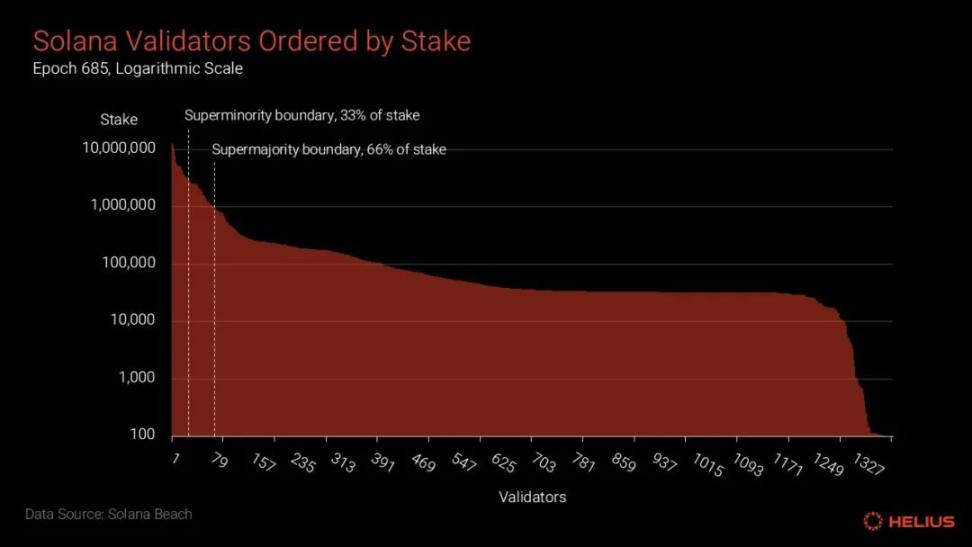
To clarify further, the following chart groups validators by delegated stake. Among them, 82 validators (5.87% of the total) hold over 1 million delegated SOL; 825 validators (59.1% of the total) have delegated SOL of less than 50,000, most of whom participate in the Solana Foundation Delegation Program (SFDP), which aims to help smaller validators achieve sustainable growth quickly. About 72% of Solana validators benefit from the support of SFDP, which collectively accounts for 19% of the total stake. For an in-depth discussion of SFDP, please refer to our earlier published Helius report: "SFDP and the Challenges Faced by Long-Tail Validators."
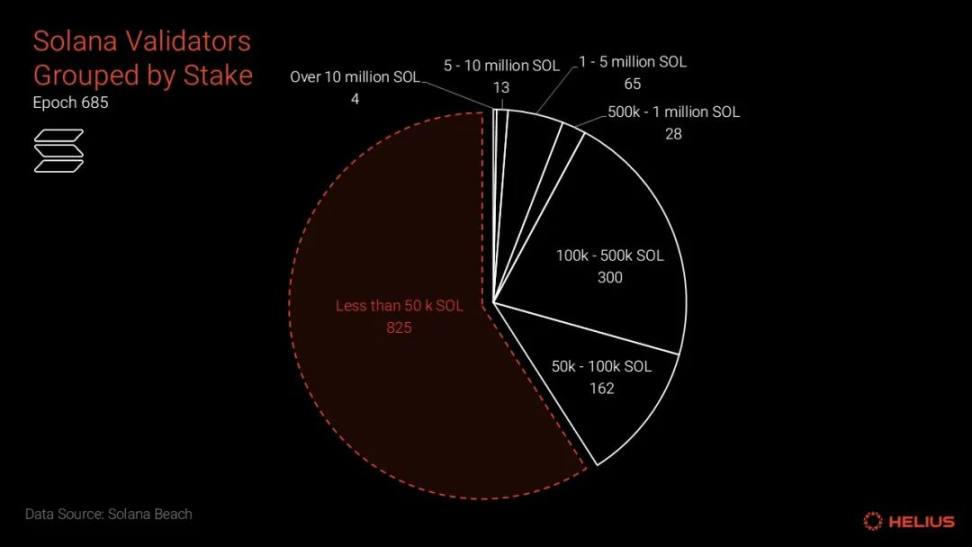
Just as blockchain addresses do not equate to users, the number of validators does not reflect the true number of different entities operating validators. Large entities may choose to distribute their staked amounts across multiple validators, resulting in a lower actual number. For example, Jito (1,2), Coinbase (1,2), and Mrgn (1,2) operate multiple validators.
There is no inherent problem with a single entity operating multiple validators; in fact, as long as the validators are distributed and not centralized, it can strengthen the network by enhancing geographical and hosting service provider diversity. However, if these validators adopt non-standard settings or firewall rules for the same configuration, risks may arise. Additionally, as part of the "validator as a service" model, having a single entity manage numerous validators on behalf of large companies or projects may pose further decentralization issues.
Nakamoto Coefficient
In proof-of-stake networks, the Nakamoto Coefficient (NC) indicates the minimum number of nodes required to control at least one-third of the total stake. The higher the coefficient, the broader the staking distribution and the higher the degree of decentralization. Additionally, it can also be viewed as the minimum number of independent entities that can collude maliciously to cause a failure of validity, thereby refusing to reach the consensus required for new block production. Blockchains based on PoS and Byzantine fault tolerance require more than two-thirds of the staked nodes to reach consensus on the network state to continue processing transactions.
To determine Solana's Nakamoto Coefficient, we arranged the validators by their staked share from highest to lowest and calculated the number of validators needed to control one-third of the total stake. The result shows that Solana's Nakamoto Coefficient reached a peak of 34 on August 13, 2023, and is currently at 19. This coefficient has remained relatively stable over the past year.
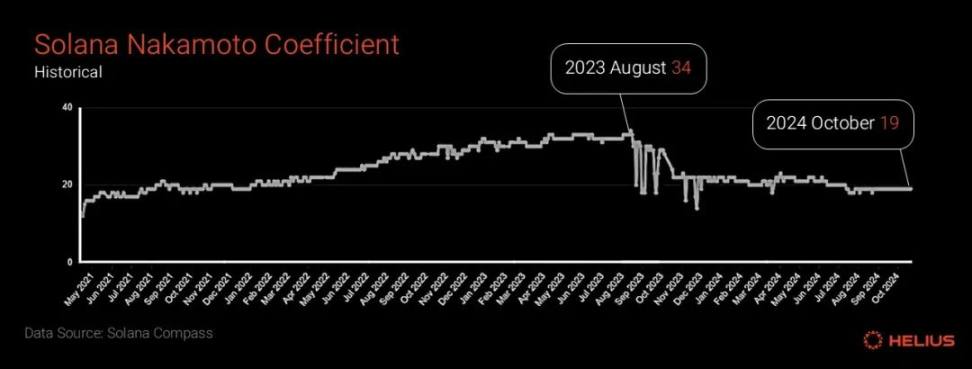
In contrast, Ethereum's staking distribution is similar, but North America has a higher weight at 34.4%.
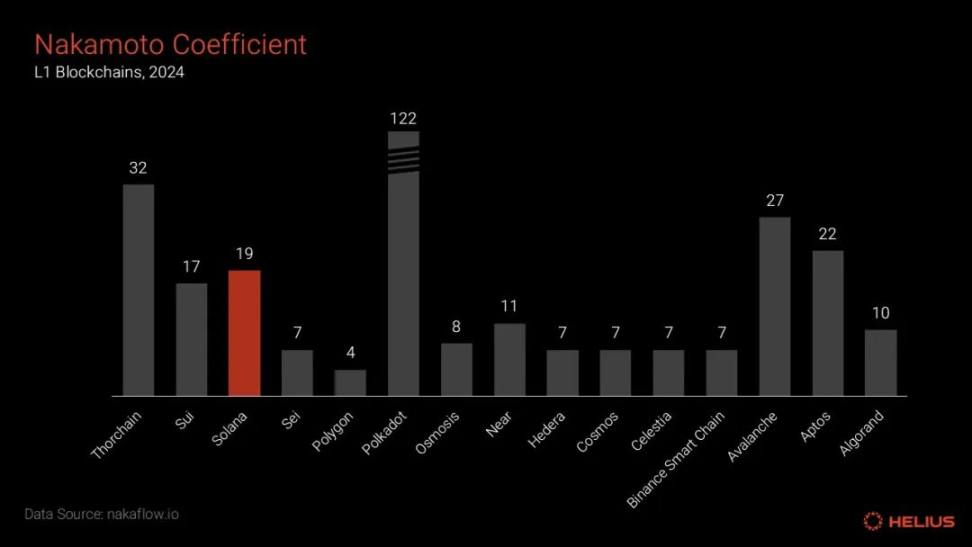
Geographical Distribution of Solana Validators by Country and Region
Solana's validators are distributed across 37 different countries and regions. The largest concentration is in the United States, with 508 validators (37%) operating in U.S. data centers, followed by 112 validators (8%) in the Netherlands and 111 validators (8%) in Russia.
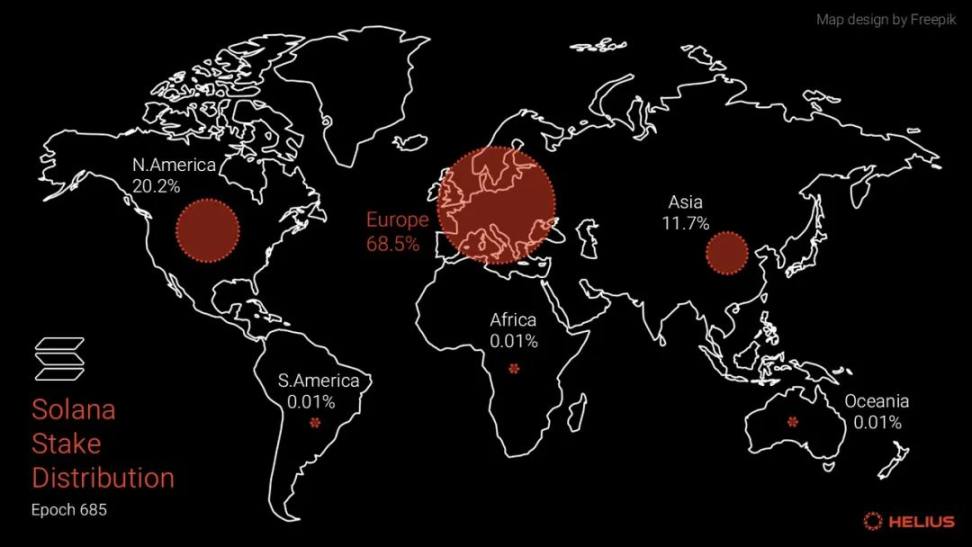
Geographical Distribution of Solana Validators by Staked Share
When measuring validators by staked share, this distribution is more balanced. Four major jurisdictions each hold more than 10% of the share, with the U.S. at 18.3%, followed by the Netherlands and the UK, each at 13.7%, and Germany at 13.2%.
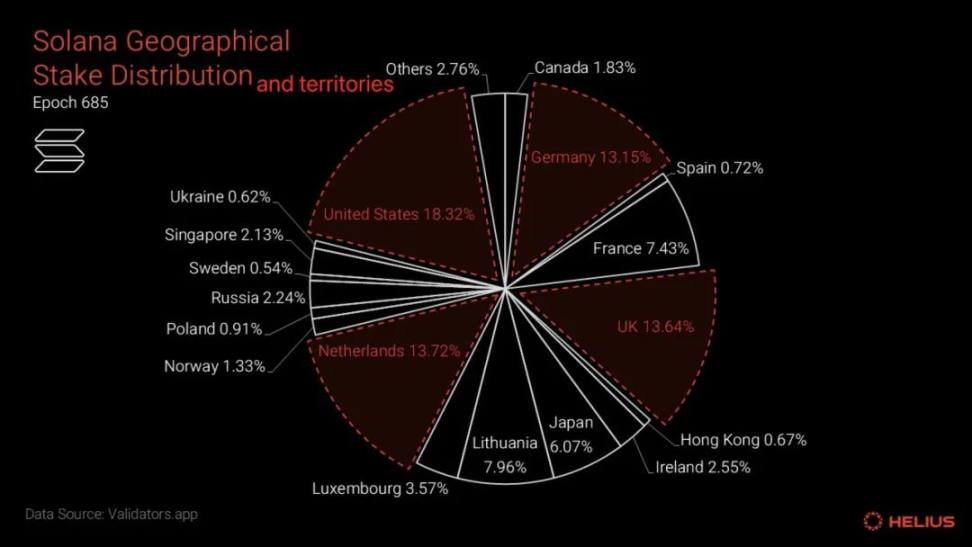
In contrast, Ethereum nodes are distributed across 83 different countries and regions, with nearly half located in the U.S. and Germany.
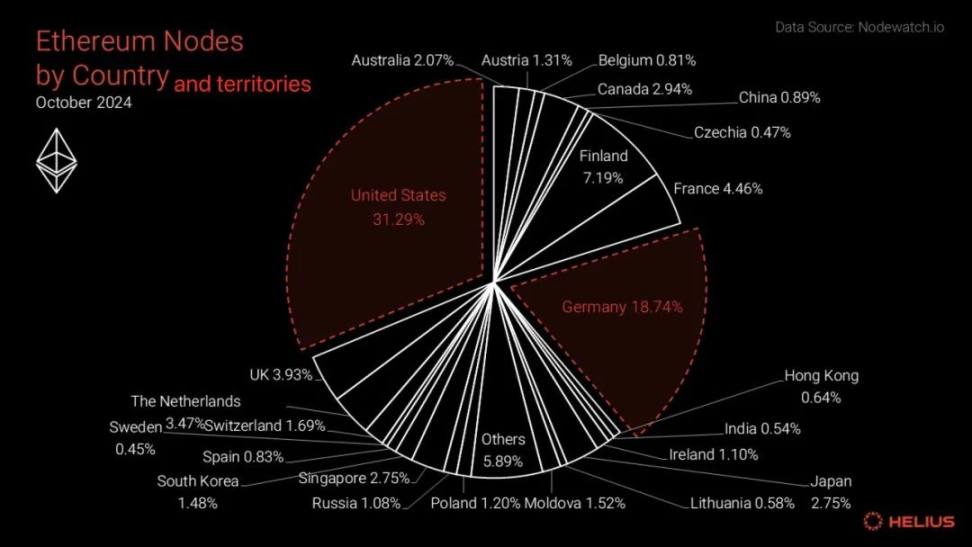
Top 10 Cities Ranked by Solana Node Count and Staked Share
A more detailed analysis of validator and delegated stake distribution by city shows that Solana validators are spread across 121 cities worldwide.
Specifically, in the U.S., validators are distributed across all major regions, totaling 35 cities. The most popular cities are Chicago (124 validators, staked share 2.3%), Los Angeles (57 validators, staked share 2.3%), and New York (32 validators, staked share 3.5%).
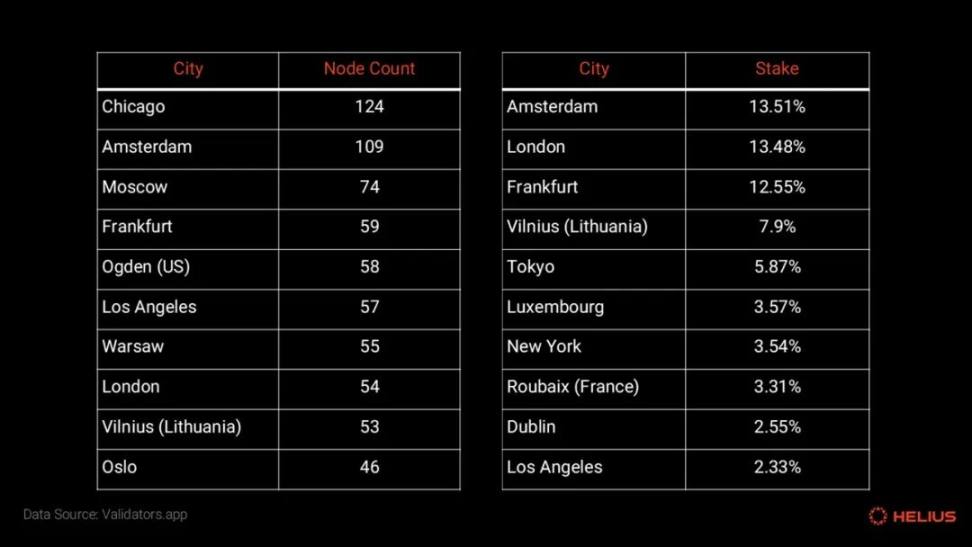
Earlier this year, Anza employee Rex St. John proposed a strategy to improve the geographical diversity of Solana validators (particularly by expanding support for operators in the Global South) and identified several key challenges:
- High Latency: Nodes in remote areas struggle to stay in sync with the network.
- Bandwidth Costs: Bandwidth costs are very high in some regions.
- Regulatory Restrictions: Laws implemented in different jurisdictions limit the feasibility of operating blockchain infrastructure.
- Underdeveloped Infrastructure: Insufficient network and data center infrastructure.
- Unfavorable Taxes and Tariffs: High costs of hardware equipment.
- Talent Shortage: Lack of local specialized Solana talent and limited pathways to obtain the capital needed for staking.
Hosting Providers
Ideally, the validator set should be hosted by multiple independent providers rather than heavily relying on a few centralized providers. This diversification is crucial for reducing the risk of network disruption or censorship from any single provider.
A notable incident in 2022 involved the German hosting service provider Hetzner, which unexpectedly removed Solana validators from its services, causing over 20% of active staked nodes (about 1,000 validators) to go offline within hours. Nevertheless, Solana continued to operate normally without any failure issues. Most affected validators successfully migrated to new data centers within days, and nearly all staked nodes came back online within weeks.
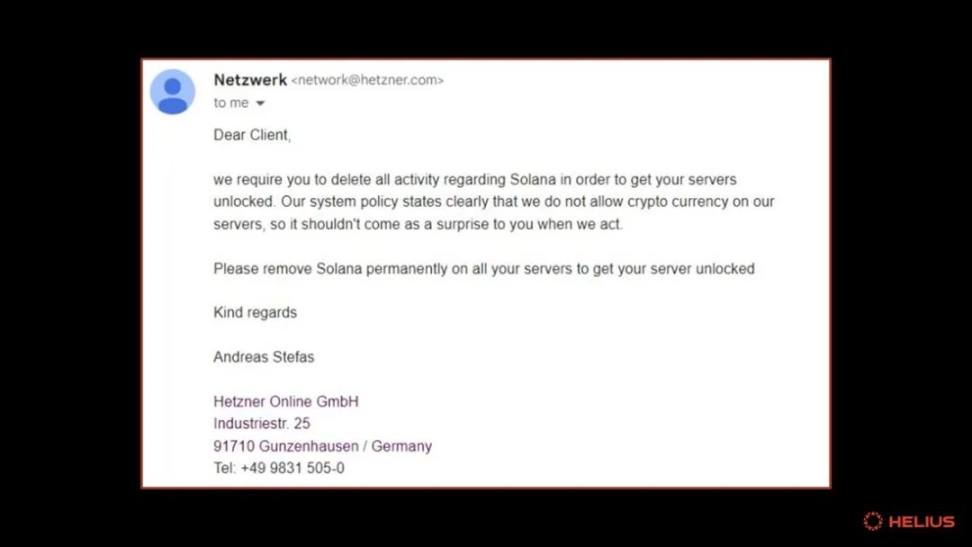
Solana Validators by Hosting Provider Classified by Staked Share
Solana validators are distributed among 135 different hosting providers, led by Teraswitch and Latitude.sh (formerly Maxihost). The former is a private U.S. company hosting 24% of validators, while the latter is a Brazilian low-cost bare-metal server provider hosting 19% of validators. Together, these two providers account for 43.4% of the share.
Other popular hosting providers include the French cloud computing company OVHcloud (8.65% share) and Cherry Servers in Lithuania (8.45% share).
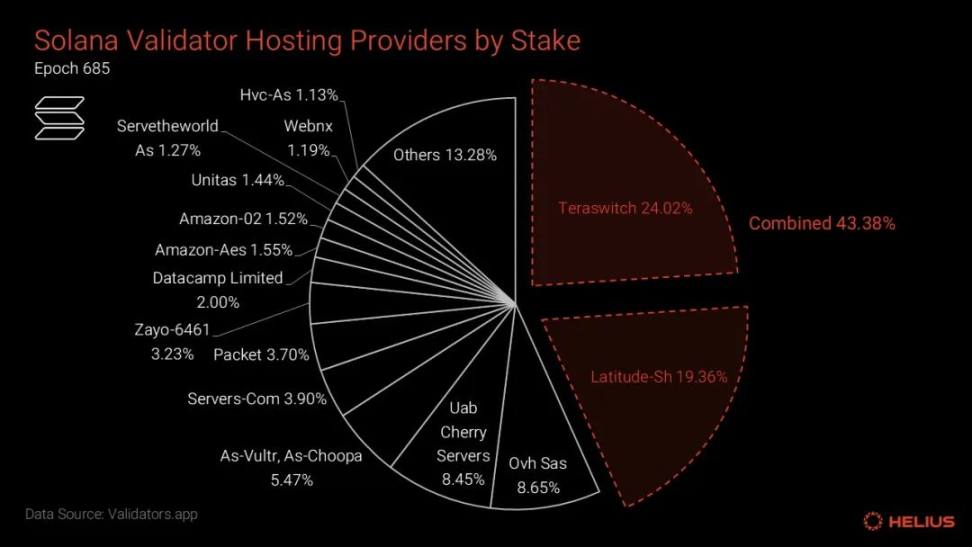
Solana Validator Hardware Requirements
As a high-performance, high-throughput blockchain, Solana has higher requirements for nodes than most of its industry peers. The hardware recommendations for Solana validators include the following key components:
- CPU: 24 cores / 48 threads or more, with a base clock speed of 4.2GHz or faster.
- Memory: 512 GB.
- Disk: PCIe Gen3 x4 NVME SSD or higher, 2TB combined or larger. High TBW.
- No GPU requirements.
In practice, Solana's bandwidth requirements make home operations impractical, so validators are primarily run on bare-metal servers in dedicated data centers.
Diversity of Solana Clients
At its launch, Solana had only one validator client developed by Solana Labs and written in Rust. Although Solana Labs' client is no longer actively updated, a fork called Agave is still in use. Relying entirely on a single client implementation is a significant manifestation of centralization, as it poses the risk of critical software bugs leading to a failure of the entire network's validity.
Increasing client diversity has been a top priority for the Solana community, and this goal has finally been achieved with the introduction of Firedancer.
Solana Clients
Currently, multiple Solana client solutions are either running or in development:
- Agave: A fork of the original Solana Labs client, written in Rust, maintained by the Solana software development company Anza.
- Firedancer: Maintained by Jump Crypto, it is a complete rewrite of the original client in C.
- Frankendancer: A hybrid validator that combines Firedancer's network stack and block production components with Agave's execution and consensus.
- Jito: A fork of the Agave client built by Jito Labs, introducing off-protocol block space auctions that provide more economic incentives for validators through tips.
- Sig: A read-optimized Solana validator client written in Zig by Syndica.
Additionally, Mithril is a client written in Golang, developed by Overclock, which can be used as a full node with lower hardware requirements.
Having multiple full-time core engineering teams review each other's codebases significantly increases the likelihood of discovering errors while promoting knowledge sharing and collaboration. Anza engineer Joe Caulfield noted in a recent interview, "We learned a lot from the Firedancer client team; they came up with a lot of very clever solutions." Furthermore, both Agave and Firedancer have launched bug bounty programs.
Diversity of Solana Clients vs. Ethereum
Solana and Ethereum are the only L1s that offer multiple client implementations. Ethereum has at least five major software clients. The most widely used are Nethermind, written in C, with a usage rate of 45%, and Geth, written in Go, with a usage rate of 39%.
On Solana, the Jito client currently accounts for 88% of staked nodes. However, with the gradual introduction and integration of new clients (Frankendancer and Firedancer), this landscape is expected to change significantly in the next 12 months.
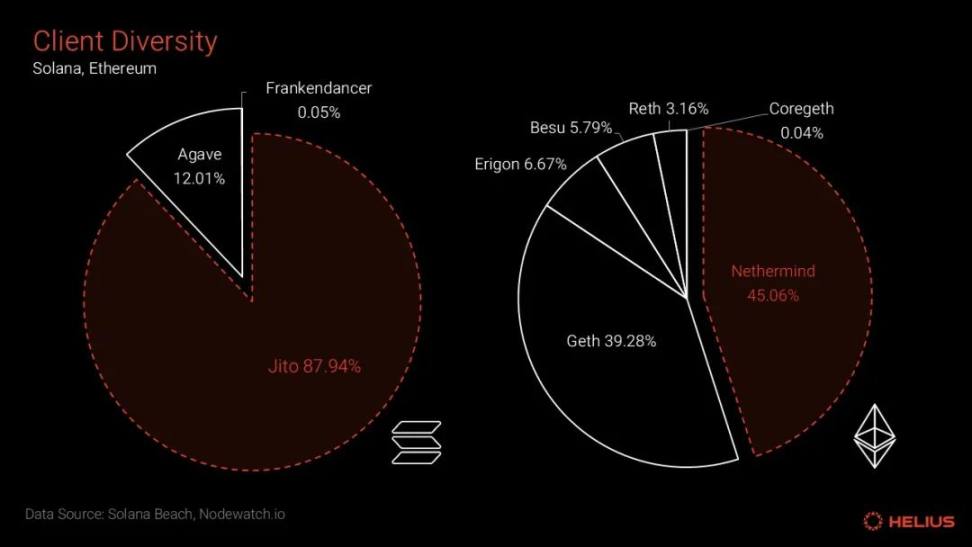
Developer Decentralization
In the book "Quantifying Decentralization," Balaji argues that developer decentralization is a key factor in the blockchain ecosystem, emphasizing the importance of minimizing reliance on individual contributors and reducing "key person risk."
All core client software on Solana is publicly hosted on GitHub under open-source licenses, allowing for open access and community contributions.
The Agave validator, maintained by the software development company Anza, founded in early 2024, plays a significant role in this area. Anza was established with about 45 employees, roughly half of the previous workforce of Solana Labs. In addition to managing Agave, the Anza team contributes to the broader Solana ecosystem through projects such as developing token extensions, cross-border payment infrastructure, and Solana's permissioned environment.
Number of Contributors to the Agave Client Codebase
The Agave client codebase has 357 contributors and 26,408 commits, but the data regarding the original commit count is not perfect and does not fully reflect the depth of individual contributions. Notably, the majority of commits are primarily authored by a small group of developers, mainly senior engineers and co-founders of Solana, along with a long list of minor contributors.
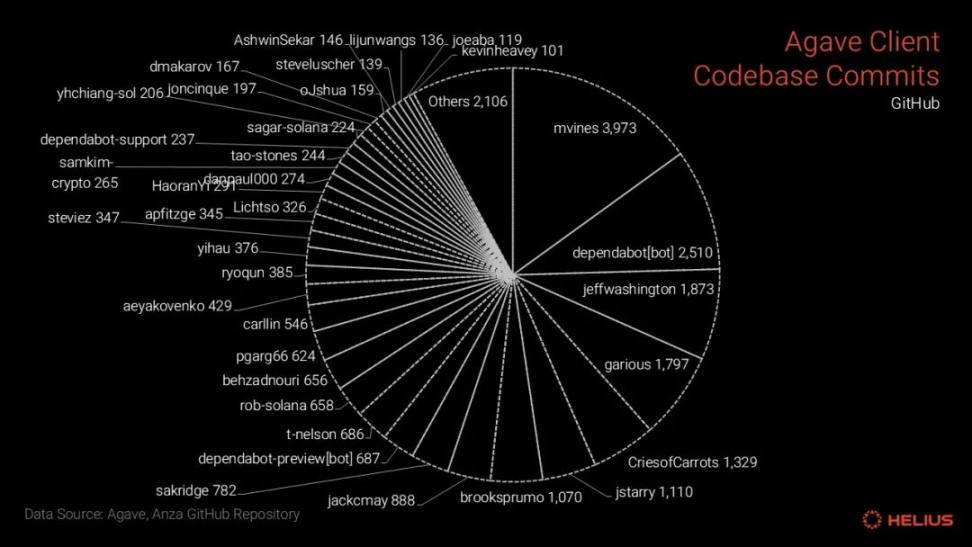
In contrast, the popular Geth and Nethermind clients on Ethereum also exhibit a similar contributor "centralization" pattern within a larger community. Geth has 1,098 contributors, while Nethermind has 142. More than half of Geth's commits are attributed to three core contributors. In Nethermind, two developers account for over 50% of all commits.
Number of Contributors to the Firedancer Client Codebase
The Firedancer client is developed by a small team led by Kevin Bowers from the renowned U.S. high-frequency trading firm Jump, currently having 57 contributors and 3,722 commits. Given that Firedancer is a relatively new project (with its first commit dating back to August 2022) and has only recently gone live on the mainnet, the diversity of contributors is still limited.

Solana Ecosystem Developers
In the broader Solana ecosystem, the geographical diversity of the developer community is undeniable. Solana's biannual online hackathons are among the most participated events in the world, playing a significant role in nurturing some of the most successful Solana protocols and application teams (including Tensor, Drift, Jito, and Kamino).
The most recent "Radar" attracted 13,672 participants from 156 countries/regions, with representatives from India, Nigeria, the United States, and Vietnam being particularly prominent.
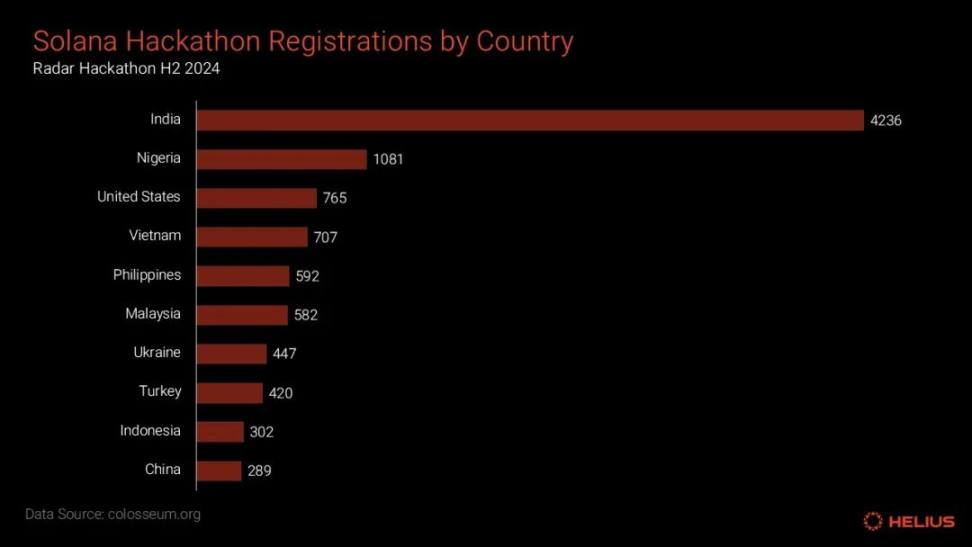
Additionally, as a network connecting Solana creators, developers, and operators, Superteam has now expanded to 1,300 members across 16 countries/regions. Its localized chapters promote collaboration by hosting events and sharing workspaces. Furthermore, the Solana Allstars ambassador program initiated by Step Finance has achieved great success in Nigeria, hosting over 120 meetups in various regions with a steady stream of participants.
Governance
Governance is an important vehicle for decentralization as it determines how decisions are made within the network. This affects all aspects, from protocol upgrades to economic policies and community rules. Decentralized governance can enhance the network's transparency, fairness, and trust.
Governance Voting and SIMD
The Solana Improvement and Development (SIMD) proposal is the formal document required for any substantial changes to Solana's core components. The definition of "substantial" changes refers to those that typically alter the network protocol, transaction validity, or interoperability. Non-substantial changes, such as minor code refactoring or objective performance improvements, do not require a proposal.
While submitting SIMD does not require any permission and any developer or researcher can submit, most SIMDs are submitted by developers from client teams who work full-time on core protocol improvements.
There are two types of SIMD proposals:
- Standard Proposals: Affecting Solana's core functionalities (such as consensus, network, and API interfaces).
- Meta Proposals: Involving processes or guidelines outside the codebase.
SIMD Process
SIMD typically goes through stages such as idea review, drafting, review, and acceptance. Formal reviews are conducted publicly on GitHub, with the proposal authors responsible for gathering feedback from relevant core contributors, who then decide whether to accept, modify, or withdraw the proposal. Authors are not obligated to implement their proposals, but it is generally advised that they do so, as this is the best way to ensure the successful completion of the proposal.
If a proposal is accepted, it usually includes a related feature implementation tracking issue and may need to be activated through Solana's feature-gate mechanism. Feature gates are activated first on Testnet based on time constraints, then on Devnet, and finally on Mainnet.
Discussions regarding improvements involve the following areas:
- SIMD (Solana Improvement Document) GitHub repository
- sRFC (Solana Request for Comments) section on the official Solana forum
- Solana technical discussion area
- Social channels, including X (formerly Twitter) and Telegram
Solana Governance Voting Process
SIMDs that significantly change the protocol, especially those affecting economic parameters, must go through governance voting. The Solana governance voting process is a relatively new initiative, initiated by long-term members of the validator community, focusing only on key issues to maintain participation and avoid governance fatigue.
So far, three such votes have been conducted, including:
- The first consultative vote in October 2023 (with 14.3% of staked nodes participating)
- SIMD33 on timely voting points in April 2024 (with 53% of staked nodes participating)
- SIMD96 on paying full priority fees to validators in May 2024 (with 51% of staked nodes participating)
Voting is conducted by depositing tokens into each validator's identity account, with the number of tokens received by each account proportional to its active staked share in lamports.
To vote, validators need to transfer tokens to one of several designated public keys corresponding to the voting options (including abstention). Once voted, changes cannot be made.
In this structure, SOL token holders participate indirectly by delegating their SOL to validators whose voting choices align with their values or preferences.
Governance Benchmark
According to a benchmark report released by CCData earlier this year, Solana is one of only four AA-rated assets among the top 40 digital assets assessed against environmental, social, and governance (ESG) standards. In the governance rating of the report, Solana ranks fourth among L1s, with evaluation factors including stakeholder participation, transparency, and degree of decentralization.
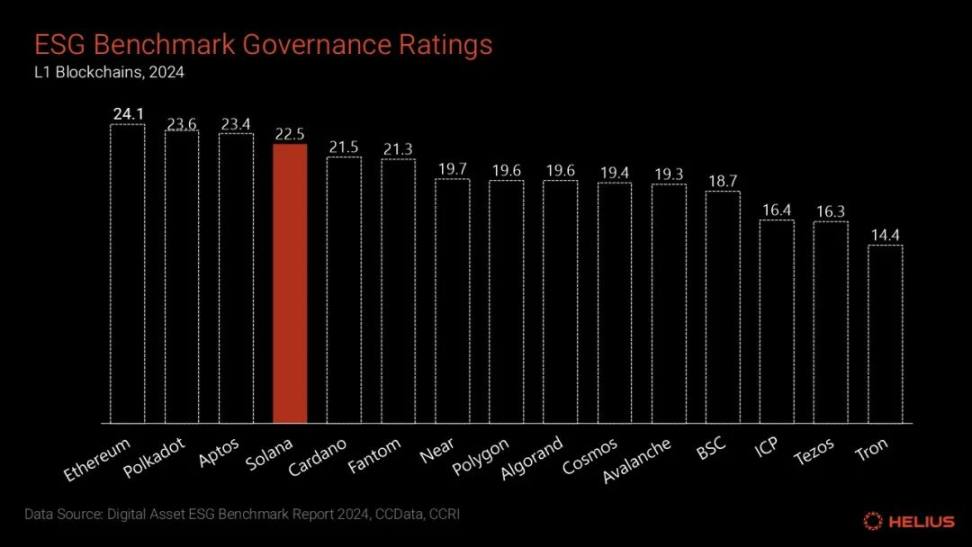
Solana Foundation
The Solana Foundation (SF), established in June 2019, is a non-profit organization registered in Switzerland, dedicated to the decentralization, adoption, and security of the Solana ecosystem. SF has an initial fund of 167 million SOL tokens and is responsible for overseeing the funding sources for grants, delegation programs, and developer tools. It controls the official brand assets, social media accounts, website, and trademarks.
Currently, SF is led by Executive Director Daniel Albert and President Lily Liu, and operates with a relatively lean team of 60-65 full-time employees, under the oversight of the foundation's board.
The foundation's mission is to build a scalable, self-sustaining Solana ecosystem, focusing on education, research, and ecological development programs. SF organizes large-scale Solana events, including Hacker Houses and the annual Breakpoint conference, to promote developer engagement and community building.
The SF developer relations team is responsible for maintaining official documentation, social channels, and developer education. In January 2024, SF transferred the management of its flagship hackathon to Colosseum, a new independent accelerator co-founded by former SF growth director Matty Taylor.
Dan Albert noted in a recent debate, "Our job is to work ourselves out of a job, find scalable ways to support the network and ecosystem, and then let go." This indicates that SF's long-term goal is to establish a network that can sustain itself without oversight.
Summary
As described in this article, Solana's decentralization is on par with, or even surpasses, its industry peers across many key metrics, including the Nakamoto coefficient, geographical distribution of validators and staked nodes, developer decentralization, and governance benchmarks. However, client diversity remains a notable issue, which the new Firedancer client aims to address.
To strengthen Solana's decentralization, the following aspects could be considered:
- Explore options for distributing SF's responsibilities among multiple organizations.
- Increase transparency in foundation spending and grant distribution.
- Develop initiatives like "Solana Nations" to enhance geographical diversity.
- Reduce the maximum expenses for validator operators, namely voting costs.
- Explore strategies to reduce data output demands on validators; data output costs for validator operators outside the EU and the U.S. are significantly higher.
- Encourage more active participation in governance voting.
- Expand Solana's core contributor and research community to strengthen the network's development.
Currently, the Solana validator set is still somewhat concentrated in the U.S. and EU, relying on a limited number of hosting service providers. While this challenge is not unique to Solana, it highlights the potential for Solana to improve its decentralization in this regard.
Lastly, thanks to Overclock, Amira Valliani, Matt Sorg, Yelena Cavanaugh, Dan Albert, Tim Garcia, 0xIchigo, Anatoly Yakovenko, and Brady Werkheiser for reviewing early versions of this article.
免责声明:本文章仅代表作者个人观点,不代表本平台的立场和观点。本文章仅供信息分享,不构成对任何人的任何投资建议。用户与作者之间的任何争议,与本平台无关。如网页中刊载的文章或图片涉及侵权,请提供相关的权利证明和身份证明发送邮件到support@aicoin.com,本平台相关工作人员将会进行核查。



